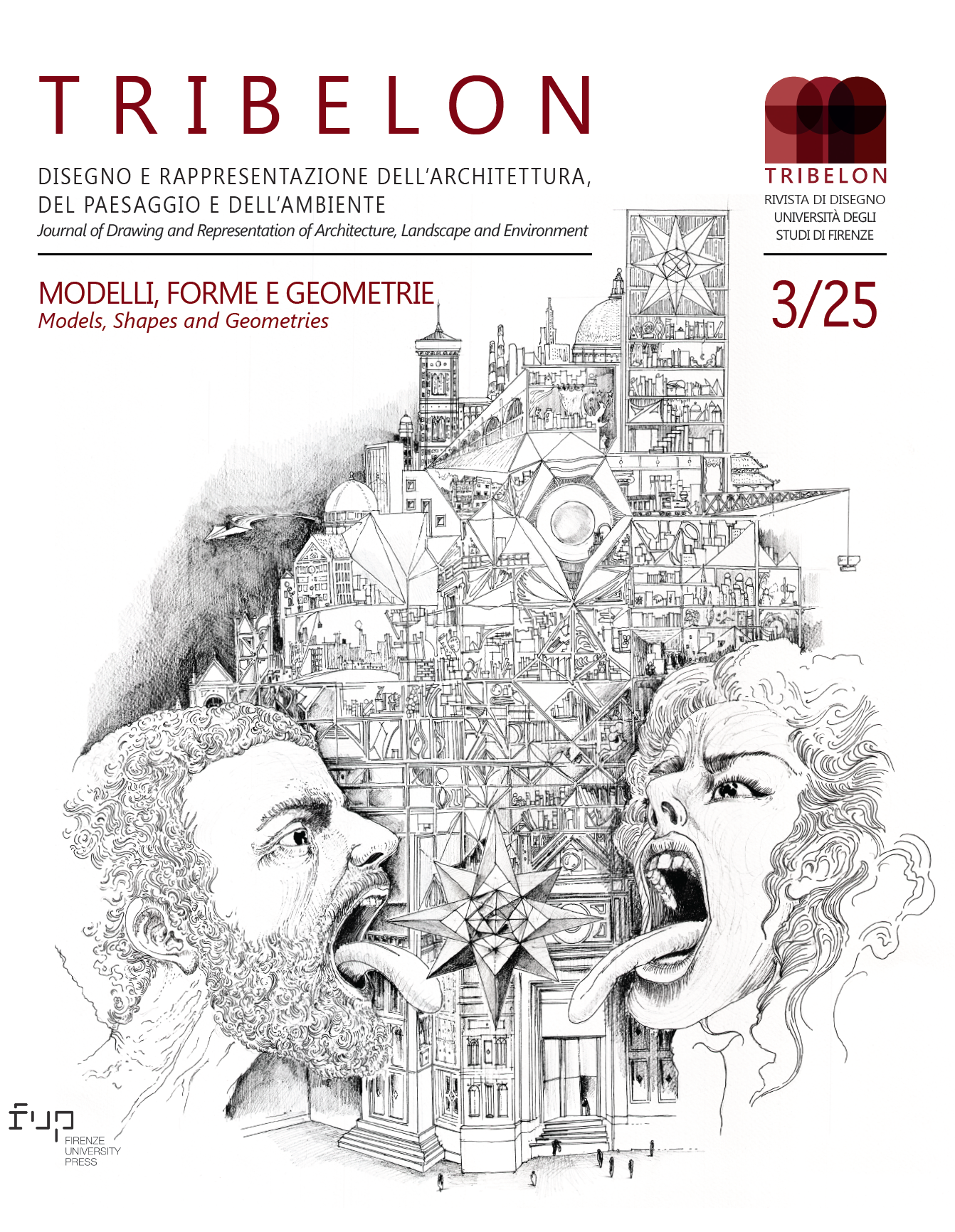Published 2025-06-09
Keywords
- Stereotomy,
- Descriptive Geometry,
- Projections,
- Drawing
How to Cite
Copyright (c) 2025 Andrea Giordano, Rachele Angela Bernardello

This work is licensed under a Creative Commons Attribution 4.0 International License.
Abstract
The eighteenth‐century studies on Perspective, of a rigorously scientific nature ‐ begun so brilliantly and synthetically by s'Gravesande ‐ reached their peak with the Brook Taylor and Lambert works. Although some of the later works rise notably for their scientific quality and expository rigor, the period of maximum development of Perspective can be considered concluded at the end of that century. In agreement with G. Loria, it was precisely in that period that a new branch of mathematics came to maturity, which was to take the place of Perspective as a trait d'union between the exact sciences and the arts of drawing. In fact, the interest aroused by the codification of the double orthogonal projection, destined to assume a dominant role in the corpus of the nascent Descriptive Geometry, will attract the interest of scholars, even if its intuitive use was already widespread, as demonstrated for example by Durer's drawings. In addition, the tradition of Stereotomy, which had always employed this type of representation, allowed obtaining directly from the graph those metric and angular data necessary for a correct 'cutting of the stones'.
In this sense, we propose a theoretical reflection about the eighteenth‐century treatises on Stereotomy, where we find, together with an exceptional graphic quality, founding aspects of Descriptive Geometry, codifed by Monge.
References
- E. Amodeo, La scienza della prospettiva nel secolo XVIII, i nuovi indirizzi scientifici che da essa scaturirono e la ripresa della Geometria descrittiva, in Atti della Società Italiana per il progresso della Scienza, Roma 1934‐35.
- É. Barbin, Monge’s Descriptive Geometry: His Lessons and the Teachings Given by Lacroix and Hachette, In É. Barbin, M. Menghini, K. Volkert (eds.), Descriptive Geometry, The Spread of a Polytechnic Art. International Studies in the History of Mathematics and its Teaching, Springer Cham 2019.
- A. Becchi, H. Rousteau-Chambon, J. Sakarovitch, Philippe de La Hire (1640-1718). Between Architecture and Science, Picard, Paris. 2013.
- J. Calvo López, Stereotomy: Stone Architecture and the Structure of Thought, Cham Springer, 2020.
- U. Bottazzini, I ‘‘politecnici” francesi, in P. Rossi (a cura di), Storia della scienza moderna e contemporanea - Dall’età romantica alla società industriale, tomo 1, TEA, Milano 2000.
- V. Cardone, Gaspard Monge. Scienziato della Rivoluzione, CUEN, Napoli 1996.
- M. Chasles, Aperçue historique sur l’origine et le développement des méthodes en géométrie, Bruxelles 1837 (Ristampa anastatica Sceaux 1989).
- P. Courcier, De sectione superficei sphaericae per superficiem sphaericam cylindricae per cylindricam et conicae per conicam, Divionae 1662.
- J. De La Gournerie, Recherches sur les surfaces tétraèdrales symétriques, Parigi 1867.
- J. B. de La Rue, Traité de la coupe de pierres, Parigi 1728.
- C. D’Aviler, Cours d’Architecture. Qui Comprend les Ordres de Vignola, Parigi 1760.
- M. Chasles, Aperçu historique sur l’origine et le développement des méthodes en géométrie, Bruxelles 1837, Parigi 1986.
- N. F. A. de Chastillon, Traite des ombres dans le dessin géométral, in T. Olivier, Applications de la géométrie descriptive aux ombres, a la perspective, a la gnomonique et aux engrenages, Parigi 1847.
- F. Derand, L’Architecture des Voûtes, Parigi 1643.
- A. De Rosa, Geometrie dell’ombra. Storia e simbolismo della teoria delle ombre, CittàStudi Edizioni, Milano 1997.
- A. F. Frezier, La Théorie et la pratique de la coupe des pierres et des bois, pour la construction des voutes et autre parties des bâtiments civil et militaires, ou Traité de stéréotomie à l’usage de l’architecture, Strasburgo 1737.
- A. F. Frezier, Eléments de stéréotomie à l’usage de l’architecture pour la coupe de pierres. Strasburgo 1760.
- A. Giordano, Cupole, volle e altre superfici. La genesi e la forma, UTET, Torino 1999.
- A. Giordano, La geometria nell'immagine. Storia dei metodi di rappresentazione, Dal secolo dei Lumi all’epoca attuale, vol. III, UTET, Torino 2002.
- M. Jousse, Le Secret d’Architecture, La Fleche 1642.
- M. Jousse, L’Art de la Charpenterie, Parigi 1751.
- M. Kemp, La scienza dell’arte, Giunti, Firenze 1994.
- J. H. Lambert, Photometria sive de mensura et gradibus luminis, colorum et umbrae, Augsburg 1760.
- J. H. Lambert, Insignores orbitae cometarum proprietates, Augsburg 1761.
- J. H. Lambert, Anmerkungen und Zusätze zur Entwerfung der Land- und Himmelscharten, Berlino 1772 (trad. en. Notes and Comments on the Composition of Terrestrial and Celestial Maps, Esripress, Michigan 1972).
- G. Loria, Storia della geometria descrittiva dalle origini ai giorni nostri, Hoepli, Milano 1921.
- R. Migliari, Geometria descrittiva, CittàStudi Edizioni, Novara 2009.
- G. Monge, Traité élémentaire de statique, à l’usage des Écoles de la Marine, Parigi 1788.
- G. Monge, Géométrie descriptive, Parigi 1799.
- T. Olivier, Applications de la géométrie descriptive aux ombres, a la perspective a la gnomonique et aux engrenages, Parigi 1847.
- A. Perez‐Gomez, Architecture and the crisis of modem Science, Cambridge Massachusetts-Londra 1993.
- J. Sakarovitch, Epures d’architecture. De la coupe de pierre à la géométrie descriptive, Birkhauser Verlag AG, Basilea - Boston - Berlino 1998.
- M. Salvatore, La stereotomia scientifica in Amédée François Frézie. Prodromi della geometria descrittiva nella scienza del taglio delle pietre, Firenze University Press, Firenze 2012.
- J. Saurin, Démonstration de l’impossibilité de la quadrature indéfinie du cìrcle. Avec une manière simple de trouver une suite de droites qui approchent de plus d’un arc de cìrcle proposé, tant en dessus qu’en dessous, Parigi 1720.
- A. Sgrosso, La geometria nell’immagine. Storia dei metodi di rappresentazione. Tra Rinascimento e Barocco, Vol. II, UTET, Torino 2001.
- R. Taton, L’œuvre scientifique de Monge, Presses Universitaires de France, Parigi 1951.


